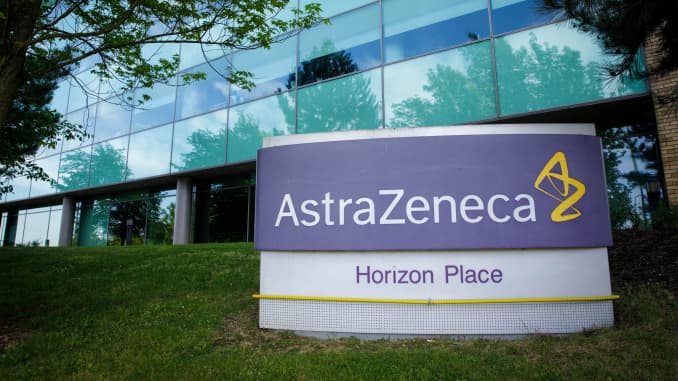 News
News
Oxford-AstraZeneca Vaccine Faces Criticism Over Lack Of Efficacy
AstraZeneca and the University of Oxford defended the results and methods used in the third phase of vaccine testing after criticism by U.S. experts, stressing that “high standards” had been used and that “further analysis would be done.”
AstraZeneca shares fell by almost 6% this week after questions were raised about a vaccine seeker, with the company saying the combined results showed it was 70% effective. This figure comes from the combination of a small group of people who inadvertently received subcutaneous vaccine – and that’s what a company spokesman called “serendipity” – produced 90% performance, and the larger group that received the highest rate, showed only 62% performance.
What Is The Reaction?
Pascal Soriot, CEO of AstraZeneca, confirmed in Bloomberg on Thursday that the major British medical company may conduct an additional international trial to test the effectiveness of its Covid-19 vaccine.
Chief of the White House’s Operation Warp Speed, Moncef Slaoui, and others in the US have expressed concern about the team tested, saying 90% success rate was only shown to the high-risk group, which had 2,741 people under the age of 55. the team whose results showed performance by 62% of the approximately 8,895.

AstraZeneca has reiterated the criticism, emphasizing the hiring of research by the Data Safety Monitoring Board (DSMB) and that the information released on Monday was only temporary and that more details would follow.
Oxford-AstraZeneca Defense
“The research has been done at a high level,” an AstraZeneca spokesman told CNBC on Thursday. “The independent security monitoring committee at DSMB is responsible for these courses to ensure safety and quality. DSMB has determined that the analysis met its final point of protection for COVID-19 that occurs 14 days or more after receiving two doses of the vaccine. ”
“Some of the information will continue to be collected and further research will be conducted to determine the timing of the protection,” the spokesman said.
Oxford University, for its part, has defined the differences between volume allocations. It stated that initial estimates of dosage of vaccines led to “half the dose of the vaccine treated as the first dose” because of “differences in the production process.”
“Concentration measures have now been developed and we can ensure that all types of vaccines are now equal,” he added.
The Critics
Serious criticism has come from the American health care company and biotech investment bank SVB Leerink, whose analysts wrote Monday: “We believe this product will never be licensed in the U.S.
“This belief is based on the creation of significant corporate trials that do not appear to comply with the FDA’s requirements for minority representation, serious cases, people infected with the disease and the elderly and so on, increasing the number of people at risk,” the analysis said.
In response, AstraZeneca spokesman emphasized that the results were temporary and that more details would be put in place and more analysis done.
Opponents of the trial have pointed out that criticism seems to be coming mostly from the US, home to only some Western vaccineers declaring high performance on their vaccine test results: Pfizer-BioNTech and Moderna, who earlier this month announced their vaccination results showed 95% effectiveness.
John LaMattina, former president of Pfizer Global R&D, wrote on Twitter on Tuesday: “It is hard to believe that the FDA will release the EUA with a high-dose vaccine given to only 2,300 people. More details will be needed for this measurement scale. ”Slaoui was previously on board in Moderna and also worked at GlaxoSmithKline.
The Cost, Logistics And Management
Outside of the U.S., the Oxford-AstraZeneca vaccine has gained popularity, especially for its ease of production and transportation and its low cost compared to its competitors. The vaccine would cost between $ 3 and $ 5 per dose and Pfizer-BioNTech and Moderna would go for $ 20 per dose and $ 32 to $ 37 per dose, respectively.
Selected for the Pfizer-BioNTech vaccine, as an mRNA vaccine, also requires extremely cold temperatures of 94 degrees Fahrenheit and special transport equipment. Moderna vaccine can be stored for up to six months after 4 degrees Fahrenheit is removed.
Oxford-Astrazeneca results “are excellent results when we remember that the barrier to adequate immunization was set at 50-60%, in line with the flu virus,” says Drs. Gillies O’Bryan-Tear, chair of policy at the Faculty of Pharmaceutical Medicine based in the UK, said Monday.
The great advantage of this Oxford vaccine over the mRNA vaccine is that it can be easily developed and transported to room temperature (not refrigerated), so it can be transported and stored using existing cold vaccine infrastructure. The group has promised to provide developing countries with this non-profit policy. ”
AstraZeneca said its vaccine could be stored, transported and stored under normal refrigeration conditions (36-46 degrees Fahrenheit) for at least six months and given within existing health care facilities. It also promised to distribute the drug for the benefit of the non-profit “period of the epidemic.”
Recent Posts
- IShowSpeed Reportedly Approached with $500 Million+ Streaming Deal
- Feeling the Pressure at 25–30? Here’s Why Young Adults Think Time Is Running Out
- BTS Is Back! All Seven Members Complete Military Service—What’s Next for the K-Pop Kings?
- Diddy’s Blockbuster Trial Nears Verdict: What’s Next for the Hip-Hop Mogul?
- “Squid Game” Final Season Sparks Global Buzz Ahead of Premiere
- Beyoncé and Jay-Z Reunite Onstage in Paris: A Night to Remember
- Texas Bets Big on Film: $1.5 Billion Incentive Law Aims to Bring Hollywood Home
- Starbucks Considers Selling Its China Business Amid Fierce Local Competition
- JetBlue Retreats from Miami and Seattle Amid Mounting Financial Pressures
- Barbra Streisand Calls Out Hollywood’s Pay Gap in Meet the Fockers Revelation


